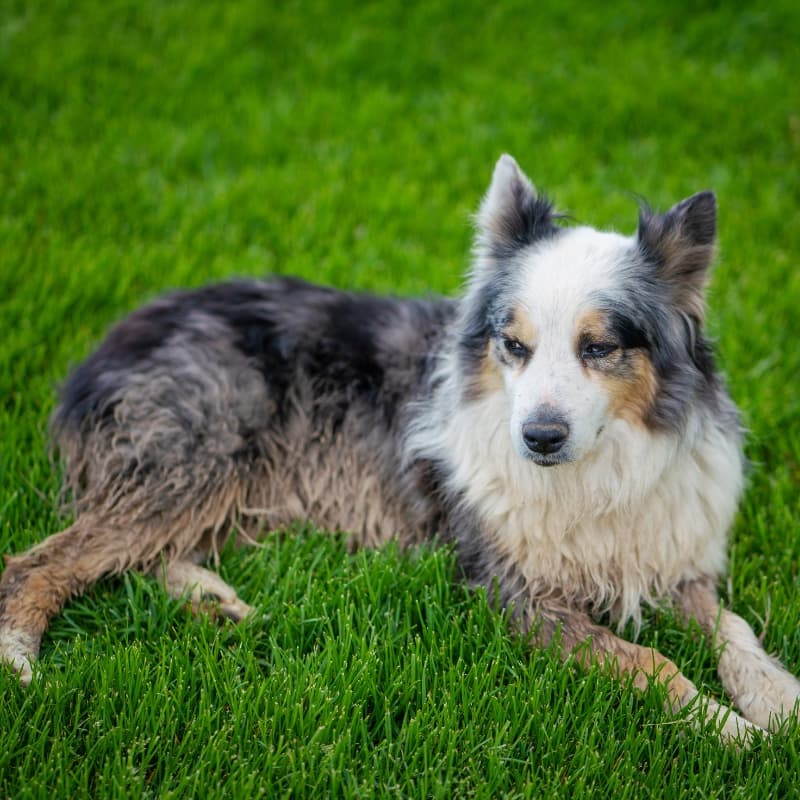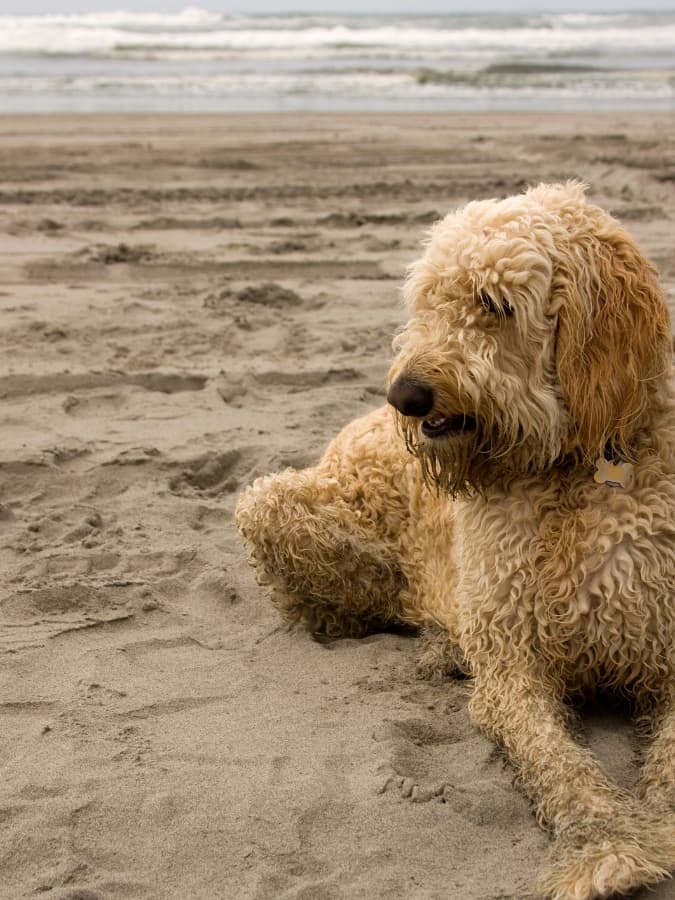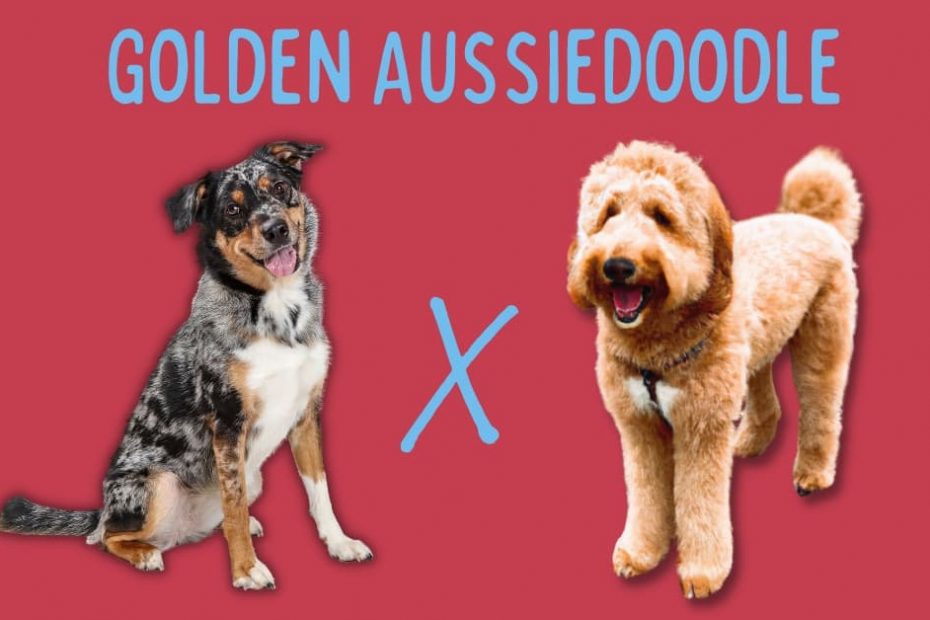In the Doodle dog world, there are a few mixes that have become mainstream. There’s the Goldendoodle, the Cockapoo, and even the rarer Saint Berdoodle and Chow Doodle.
But what happens when you add a third set of genetics to the mix? Well, you get super-rare breeds like the Golden Aussiedoodle, a new “Double Doodle” offspring of the designer Doodle dogs.
This super-energetic, loyal, and brilliant hybrid has a mix of some of the best genetics a dog owner could ask for.
What is a Golden Aussiedoodle?
The Golden Aussiedoodle, also known as the Golden Aussiepoo, is the offspring of either: one parent who is 50% Golden Retriever and 50% Australian Shepherd, and the other a purebred Poodle or a Goldendoodle (Golden Retriever and Poodle mix) and Australian Shepherd.
The latter, which seems to be the more traditional, is a next-generation offspring of Doodle breeds known as the “Double Doodle.” If there was ever a loyal breed, easily trainable, with explosive energy – the Golden Aussiedoodle is undoubtedly the picture definition.
It’s worth noting that this is NOT the Aussiedoodle – which is a mix of a purebred Australian Shepherd and a purebred Poodle. The DNA and heritage of this breed are made up of several storied beginnings.
History of the Parent Breeds
Only a small percentage of dog owners have been in the presence of these one-of-a-kind hybrids. To understand the true personality of the Golden Aussiedoodle, it’s only fair to break down the traits of the parent breeds.
Australian Shepherd

The name Australian Shepherd is a herding breed with roots in the United States. Despite popular belief, these dogs DO NOT trace their roots back to the Land Down Under, as their name is a bit misleading.
In reality, the Aussie Shepherd received its name from its descendants, who actually hail from Australia. According to Dogumentary TV, their ancestors hail from the Pyrenees Mountains – a cross between the Pyrenean Sheepdog and the Basque Shepherd Dog.
From there, it’s thought that these mixes were bred with Dingos and other herding dogs in New Zealand and Australia and eventually were included with sheep imports to the United States, along with various collie breeds.
The Aussie was first bred and coined in California in the 19th century, as it was the perfect breed to help manage the large, wide-open ranches in the largely unsettled Wild West.
Even though the Australian Shepherd is now primarily bred and sold as a non-working dog, most retain their strong instinct for herding! This breed is loyal, active, protective, and playful and often requires an active owner to accommodate their high energy and need for exercise.

One owner offers up her current experience with her Australian Shepherd:
“I have a 3 year old female. I live in town by myself. She absolutely loves to play so we play frisbee multiple times a day. She minds well and is eager to please. She’s also very affectionate. I really like the dog but she is a high–energy dog and definitely not for everyone!”
According to the AKC, the Australian Shepherd requires just as much mental stimulation as it does physically. They’re extremely gentle with children – but they’re not for the lazy owner – as these cunning dogs are known to get one over on an unsuspecting owner from time to time.
These dogs are ideal for a seasoned dog trainer, physically active person, or family who often finds themselves on outdoor excursions or journeys. They could also be suitable for a novice, up-and-coming dog trainer, as the Aussie is well known for how easily they learn new commands.
Goldendoodle

Many people are unaware that the Goldendoodle was first bred in the 1960s. This mix between the Poodle and the Golden Retriever existed throughout the 60s, 70s, and 80s, but it was a nameless breed during this window.
However, it wasn’t until the 1990s that the breed actually got its popular name after the Labradoodle rose to prominence and hybrid breeding became more mainstream [1]rover.com/blog/breeds/goldendoodle.
After the explosion in popularity, it sparked a huge wave of hybrid breeds – some that stuck, and some that didn’t – and unfortunately, many were at the hands of irresponsible breeders who created unpredictable cross-breeds.
This led to many of these hybrids with mental and physical ailments, spawning a statement from the original breeders of the Goldendoodle expressing their regret about creating the Doodle craze.
Unsatisfactory breeders aside, there’s no denying that the work done at the hands of these breeders created a beautiful line of dogs that have become known as some of the happiest, most playful, and eager-to-please breeds in existence.
The Goldendoodle size depends on the heritage of the poodle side of their genetic makeup. Their parents are either toy, miniature, or standard size, passing these same characteristics on to their Goldendoodle offspring.
Unlike the other half of their lineage, the Goldendoodle is known for shedding much less than the Golden Retriever.

The Goldendoodle comes in a variety of colors, almost always with the trademark Poodle curly hair – albeit slightly longer in nature than the standard Poodle.
This breed has been bred in brown, red, golden, grey, and white! These dogs are also known as the Golden Poo, or Groodle, and have a unique talent/trait.
Their keen sense of smell makes them a rare service animals that can smell allergies. You can train your Goldendoodle to sniff out the ingredients in your food, alerting you to any potentially harmful ingredients before you eat.
Golden Retriever

Dogumentary TV gives an excellent introduction and summary of the Golden Retriever breed:
“The Golden Retriever is a great pet. They are an amazingly loyal dogs, family-friendly – they’re sweet, they’re gentle, they’re easygoing, they’re intelligent. So, they’re very easy to train.”
The roots of the Golden Retriever can be traced back to a man named Dudley Coutts Marjoribanks (also known as Lord Tweedmouth). Walking with his son one evening, he noticed a wavy-haired sporting dog named Nous, who belonged to a cobbler who received him as a debt repayment – but had forgotten about him.
Nous was born from parents with black coats, considered better hunters and more fashionable at the time – and golden-colored sporting dogs, like Nous, were sadly “disposed of” at birth more often than not.
Eventually, Nous was bred with Belle, a Tweed Water Spaniel (now extinct), and the result was the first litter of Golden Retrievers in the world – named Cowslip, Crocus, and Primrose [2]akc.org/expert-advice/dog-breeds/behind-the-breed-golden-retriever-history.
And the rest, as they say, is history, as these loyal, intelligent, affectionate dogs became one of the most popular breeds in the United States and Europe.
Poodle

The Poodle is an energetic, athletic, and sometimes goofy companion. Known for its strong personality and unwavering loyalty, the Poodle is a versatile breed that comes in three distinct sizes: the Toy, the Miniature, and the Standard.
While it may be the national dog of the country France, the Poodle was originally bred in Germany. Their name comes from the German word “pudel” or “pudelin,” which means “to splash in the water.” [3]akc.org/expert-advice/lifestyle/10-facts-about-poodles
The Poodle was originally bred as a hunting dog, as their job was to fetch birds and other fowl for their hunting masters out of the water – making them, in reality, a form of water retriever! This is likely where they get their intelligence, energy, and high level of trainability from.
Because of their intelligence and loyalty, they make a great family – and even service dogs.
One Poodle forum member had this to say:
“They also make AMAZING service dogs! I watched a girl who had a standard as a service dog/ support dog for her Cystic Fibrosis & they make a great team/family!”
Appearance
The Golden Aussiedoodle is a stark contrast to the Goldendoodle. Because of the introduction of another long-haired breed into the mix, these dogs have noticeably longer coats. While the trademark Poodle curls are still on full display, the prominent Australian Shepherd/Golden Retriever DNA gives way to shedding.
Although not nearly as bad as the purebred varieties of the two aforementioned breeds, it’s still a good idea to keep them well-brushed and groomed to avoid any messy shedding.
It’s worth noting. It’s the colors of these dogs that make them so beautiful. These dogs can take on rust, brown, blonde, black, gray, and white overtones, with the Australian Shepherd trademark contrast patterns.
However, this doesn’t rule out the possibility of a solid color – most of the time, they are almost always multi-colored puppies. The possibilities are seemingly endless and heavily dependent on the Poodle’s genetics.
Size
Again, this heavily depends on the size of the Poodle’s genetics. Suppose the Goldendoodle parent is bred from a teacup or miniature.
In that case, the Golden Aussiedoodle will take on a smaller stature of 15-25 pounds, but not teacup size by any means.
If it’s a standard-size Poodle’s DNA, they could grow significantly larger and end up in the 35-45 pound range, taking on more of an Australian Shepherd-sized frame.
Traits & Characteristics

Temperament & Personality
These dogs take on the unique personality of all parent breeds combined. They are intelligent, easily trained, loyal, and have incredibly high energy levels!
They need plenty of mental and physical stimulation, and it’s recommended that they have at least 90 minutes per day of full-speed exercise. While energetic, they still take on a sweet, friendly demeanor courtesy of the Golden Retriever genetics and are excellent family dogs.
Common Health Issues
One of the more prominent health issues to be mindful of is the common hip dysplasia found in the Golden Retriever, the Australian Shepherd, and the Poodle.
Plenty of exercise can keep this at bay for most of the dog’s life. Another potential ailment exists in the form of cancer, both prominent in the Aussie and the Golden Retriever breeds. Frequent checks for this are recommended to keep them healthy and happy.
Lifespan
With the proper diet, exercise, and family environment, there’s no reason the Golden Aussiedoodle can’t live a life well over a decade. On average, you can expect an outlook anywhere between 9 and 12 years.
More Goldendoodle mixes!
The Golden Aussiedoodle isn’t the only notable Goldendoodle mix, check out these doods:
- Border Collie x Goldendoodle
- Corgi x Goldendoodle
- Boxer x Goldendoodle
- Goldendoodle x Siberian Husky
- Goldendoodle x Pit Bull
- Goldendoodle x Labrador Retriever


